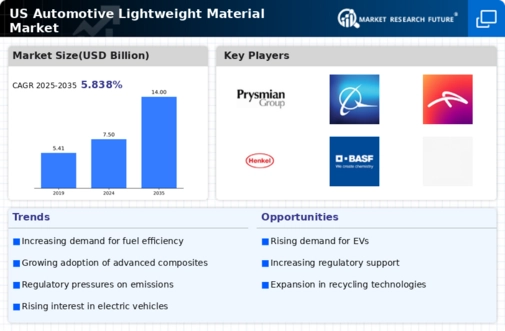Consumer Demand for Fuel Efficiency
Consumer preferences are shifting towards fuel-efficient vehicles, which is a key driver for the automotive lightweight-material market. As fuel prices fluctuate, consumers increasingly prioritize vehicles that offer better mileage. Lightweight materials, such as high-strength steel and composites, can reduce vehicle weight, leading to improved fuel efficiency. According to recent data, vehicles that utilize lightweight materials can achieve fuel savings of approximately 10% for every 10% reduction in weight. This growing consumer demand for fuel-efficient vehicles is likely to propel the automotive lightweight-material market, as manufacturers strive to meet these expectations while enhancing overall vehicle performance.
Economic Factors and Cost Efficiency
Economic factors play a pivotal role in influencing the automotive lightweight-material market. As the cost of raw materials fluctuates, manufacturers are increasingly focused on cost efficiency in production. Lightweight materials, while often more expensive initially, can lead to long-term savings through improved fuel efficiency and reduced emissions. The automotive lightweight-material market is likely to see growth as manufacturers evaluate the total cost of ownership and the potential for savings over a vehicle's lifespan. Additionally, government incentives for adopting environmentally friendly technologies may further enhance the economic viability of lightweight materials in the automotive sector.
Competitive Pressure and Market Dynamics
The competitive landscape within the automotive industry is a significant driver of the automotive lightweight-material market. As manufacturers strive to differentiate their products, there is an increasing emphasis on reducing vehicle weight to enhance performance and fuel efficiency. This competitive pressure encourages companies to invest in research and development of lightweight materials. Furthermore, partnerships and collaborations among automotive manufacturers and material suppliers are becoming more common, facilitating the introduction of innovative lightweight solutions. The automotive lightweight-material market is expected to expand as companies seek to gain a competitive edge through the adoption of advanced materials.
Regulatory Compliance and Emission Standards
The automotive lightweight-material market is significantly influenced by stringent regulatory compliance and emission standards in the US. As the government enforces stricter regulations to reduce greenhouse gas emissions, manufacturers are compelled to adopt lightweight materials to enhance fuel efficiency. For instance, the Corporate Average Fuel Economy (CAFE) standards require automakers to achieve an average fuel economy of 54.5 mpg by 2025. This regulatory pressure drives the demand for materials such as aluminum and advanced composites, which can reduce vehicle weight by up to 30%. Consequently, the automotive lightweight-material market is poised for growth as manufacturers seek to meet these standards while maintaining performance and safety.
Technological Advancements in Material Science
Technological advancements in material science are playing a crucial role in shaping the automotive lightweight-material market. Innovations in manufacturing processes, such as 3D printing and advanced molding techniques, enable the production of lightweight materials with enhanced properties. For example, the development of carbon fiber reinforced polymers has led to materials that are not only lightweight but also exhibit superior strength and durability. These advancements are expected to drive the adoption of lightweight materials in the automotive sector, as manufacturers seek to leverage new technologies to improve vehicle performance and reduce weight. The automotive lightweight-material market is likely to benefit from these ongoing innovations.

























Leave a Comment